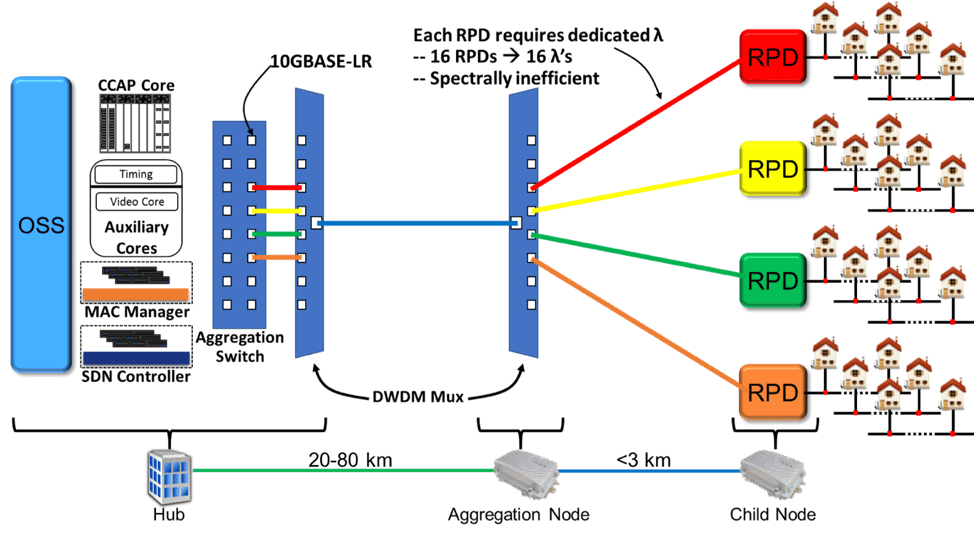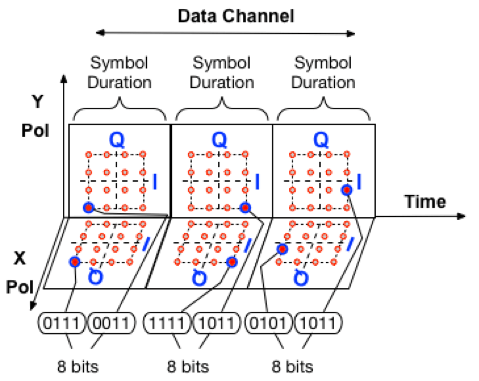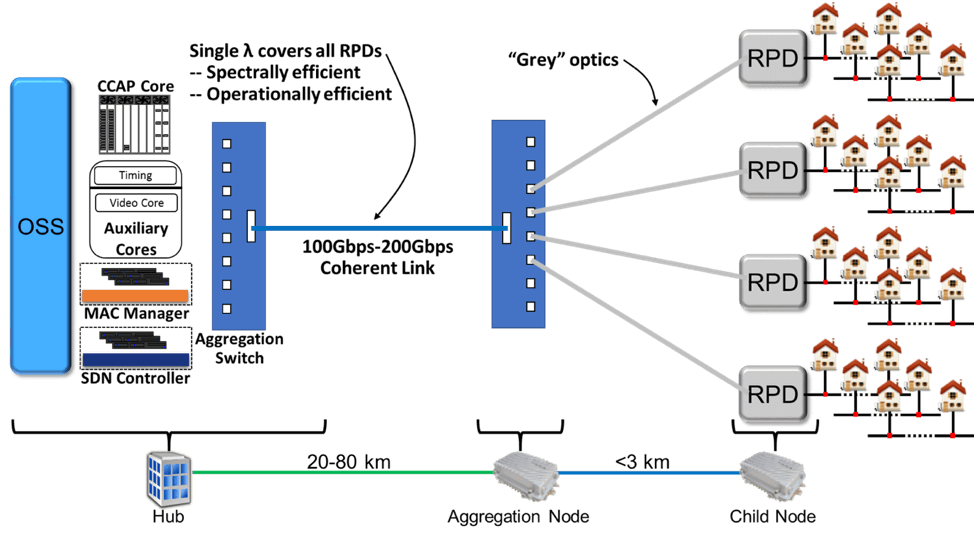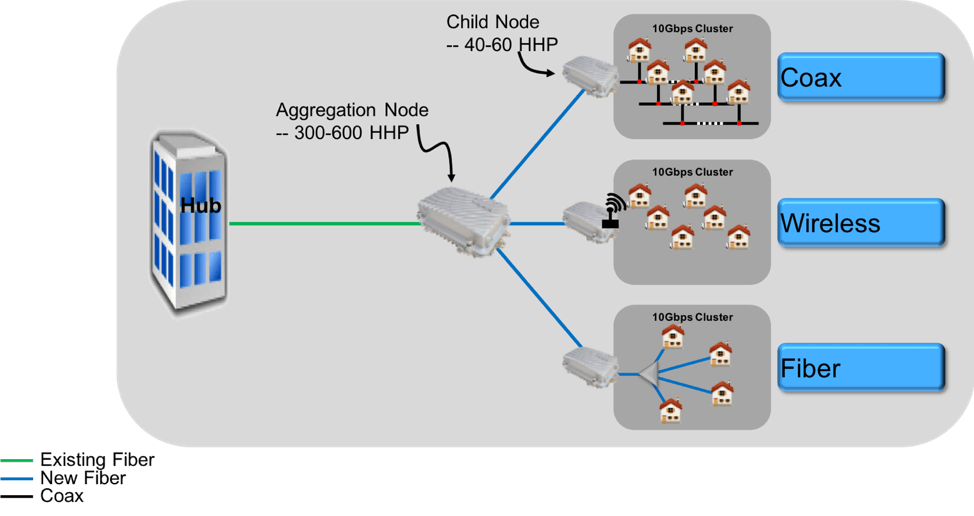Wired
First Light for CableLabs® Point-to-Point Coherent Optics Specifications

On June 29th, CableLabs publicly unveiled for the first time two new specifications:
- P2P Coherent Optics Architecture Specification
- P2P Coherent Optics Physical Layer v1.0 Specification
These two new specifications are the result of a focused effort by CableLabs, our members, and our manufacturer partners to develop Coherent Optics technology for the access network and bring it to market quickly. They also represent the beginning of a sea change for the way data is distributed into the network by:
- Greatly expanding the capacity of existing cable operator fiber access networks,
- While meeting ever-increasing capacity demands at the lowest possible cost.
The Drive for More Capacity
Have you ever met a customer that didn’t want faster speeds? That didn’t want their broadband and wireless services to be quicker, faster, and more responsive? I didn’t think so.
To meet those increasing customer expectations, there are two fundamental changes occurring in the access network of cable operators:
- Operators are deploying remote devices using CableLabs Distributed Access Architecture (DAA) technology, which requires converting the fiber network from analog to digital transport.
- They are also pushing fiber deeper into the network, such that multiple remote devices are taking the place of a single fiber node.
These two changes together enable cable operators to increase capacity more cost-effectively than traditional node splitting, while improving service quality and opening the door to new service opportunities.
Today’s Technology Option
To be able to reach those remote DAA devices (such as Remote PHY Devices, or RPDs), today cable operators are deploying multiple 10 Gbps links that share a single fiber by operating at different wavelengths (known as DWDM, or Dense Wavelength Division Multiplexing) as in the figure below:

There are limits to how many different wavelengths that can be placed onto a fiber, and the number of fibers available to use may also be limited, which together limit the growth of this option. Additionally, adding more and more wavelengths adds not only direct cost, but also operational complexity, which has its own cost.
Coherent Optics: A Brighter Solution
In order to transmit digital data – a series of 1s and 0s – across a fiber at 10 Gbps, today’s devices use On-Off Keying (OOK). In essence, devices turn the light on and off very quickly to transmit that data.
Wouldn’t it be great if we could add more information to each pulse of light?
That’s what Coherent Optics technology does: it packs multiple bits of data into each “symbol”, allowing for more data to be transmitted in the same amount of time (a.k.a, more speed). It does this by manipulating the amplitude, phase, and polarization of that light to transmit multiple bits of data with each symbol duration, as shown in the following example for 16QAM modulation:

Now, instead of each wavelength carrying 10 Gbps, with Coherent Optics technology defined in these new specifications we can carry 100 Gbps (and more) on each wavelength. And this technology is also well suited to operating with multiple wavelengths on the same fiber, dramatically increasing capacity. Where before a 40 channel fiber network could have a capacity of 400 Gbps, now it’ll be 4 Terabits per second, a full order of magnitude increase.
Interestingly, Coherent Optics technology actually isn’t new. It’s been used in long-haul networks for several years. What is new is applying it to the access network and realizing that by optimizing this technology for these shorter distances, we could dramatically reduce the cost of the technology.
The advantage of applying Coherent Optics Technology to the Access Network
Let’s take a look at that network example above, but now using Coherent Optics technology rather than multiple 10 Gbps links:

Now we can have just one or two wavelengths operating at 100 Gbps each taking the place of all of those 10 Gbps wavelengths, making network operation and management much simpler. While we still need 10 Gbps links to each of the remote DAA devices, we can use low cost, short reach optics rather than higher cost, long reach optics. This reduces overall cost and complexity compared to existing solutions, without the same limitations.
New Service Opportunities
The opportunities with Coherent Optics technology go well beyond improving service to residential broadband customers. By having a high capacity digital architecture that reaches deep into their networks, cable operators are not only able to support increasing demand for residential broadband services, but are ideally placed to support next-generation wireless services like 5G. These networks will place network endpoints right where wireless transmitters are needed, and with plenty of capacity to support wireless demand growth in addition to wired growth.

As we like to say, DAA isn’t just about DOCSIS services, and Coherent Optics is the key to opening up the capacity to unlock those services.
Why did CableLabs develop Coherent Optics specifications?
The number one objective for the CableLabs effort is to reduce the cost of this technology. The devices used today for long-haul networks are generally expensive, and therefore unsuitable for our objective of increasing capacity cost-effectively. However, much of that is driven by the fact that they have been designed for much longer distances than would be required for the access network. Our specifications reduce cost in 2 primary ways:
- They define the minimum feature set necessary for an access network application, reducing complexity and therefore cost; and
- They ensure interoperability, which increases competition and scale, thereby also reducing cost.
Through these efforts, we believe that the cost of Coherent Optics technology will be greatly reduced, making it both more economical and more future proof than existing solutions.
What do these specifications define?
The P2P Coherent Optics Architecture Specification: Defines the overall architecture for using Coherent Optics technology in cable operator access networks. It contains information about the technology itself, defines use cases for cable operators, and provides guidance on deployment scenarios. It should be seen as a resource for learning more about how to apply this technology to access networks, as well as assisting in preparing for its use.
The P2P Coherent Optics Physical Layer v1.0 Specification: Defines the requirements for coherent optics transceivers to interoperate with each other on the fiber network at 100 Gbps for each wavelength. It contains the requirements that manufacturers will need to comply with in order to make their devices interoperate with each other at these speeds while keeping cost down as much as possible. It should be seen as the guide for manufacturers to use in developing their products for this market.
What’s next?
As is implied by the Physical Layer specification being labeled as “v1.0”, there is more to come:
- CableLabs, its members, and our manufacturer partners are already hard at work on future versions of the technology that will expand the capacity of each wavelength to 200 Gbps and greater.
- We’re developing an OSSI or Operational Support Systems Interface specification to enable consistent management of Coherent Optics transceivers.
- We’re also in the planning stages for interoperability events that will demonstrate device interoperability and specification compliance at 100 Gbps speeds.
The well-lit path ahead
Through the use of Coherent Optics technology – and devices built to be compliant with the CableLabs Point-to-Point Coherent Optics Specifications – cable operators now have a means of cost-effectively meeting ever-expanding consumer demand over their existing fiber access networks, and one which also provides the opportunity to provide new services like 5G small cell backhaul and enhanced business services.
The future of the fiber network is bright, so stay tuned!


